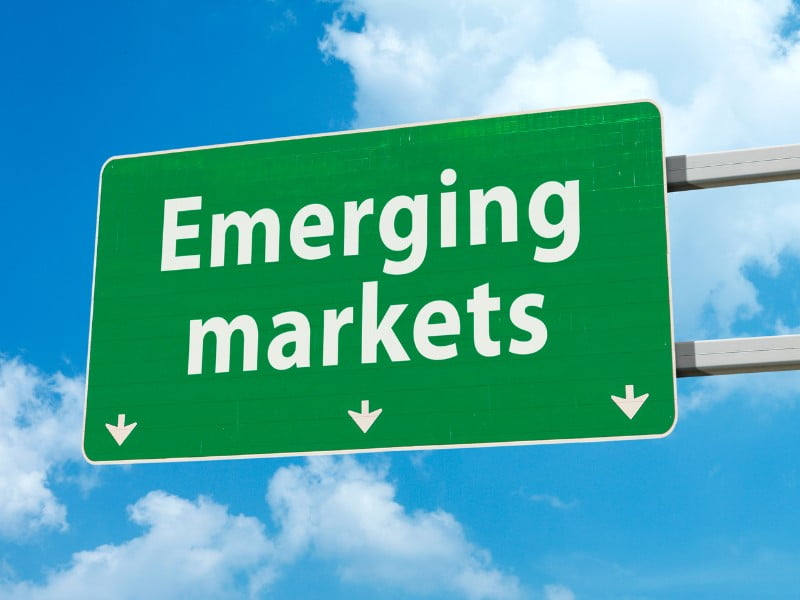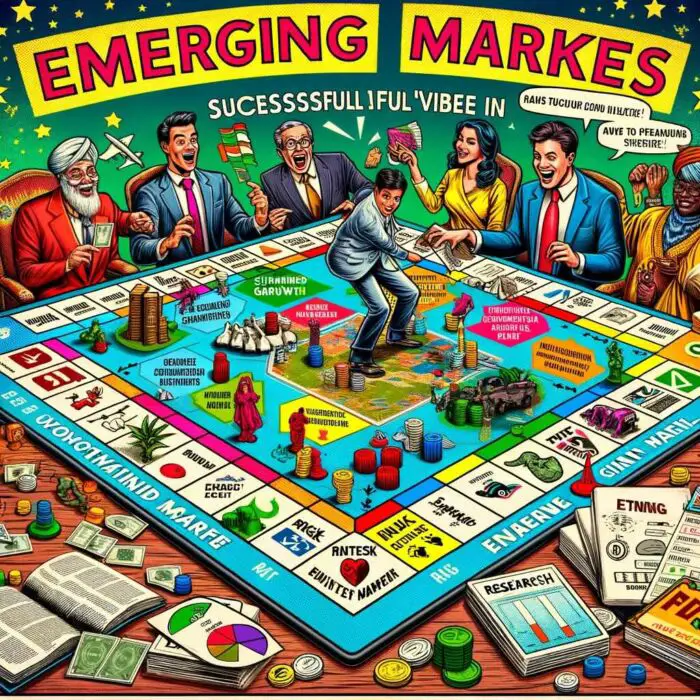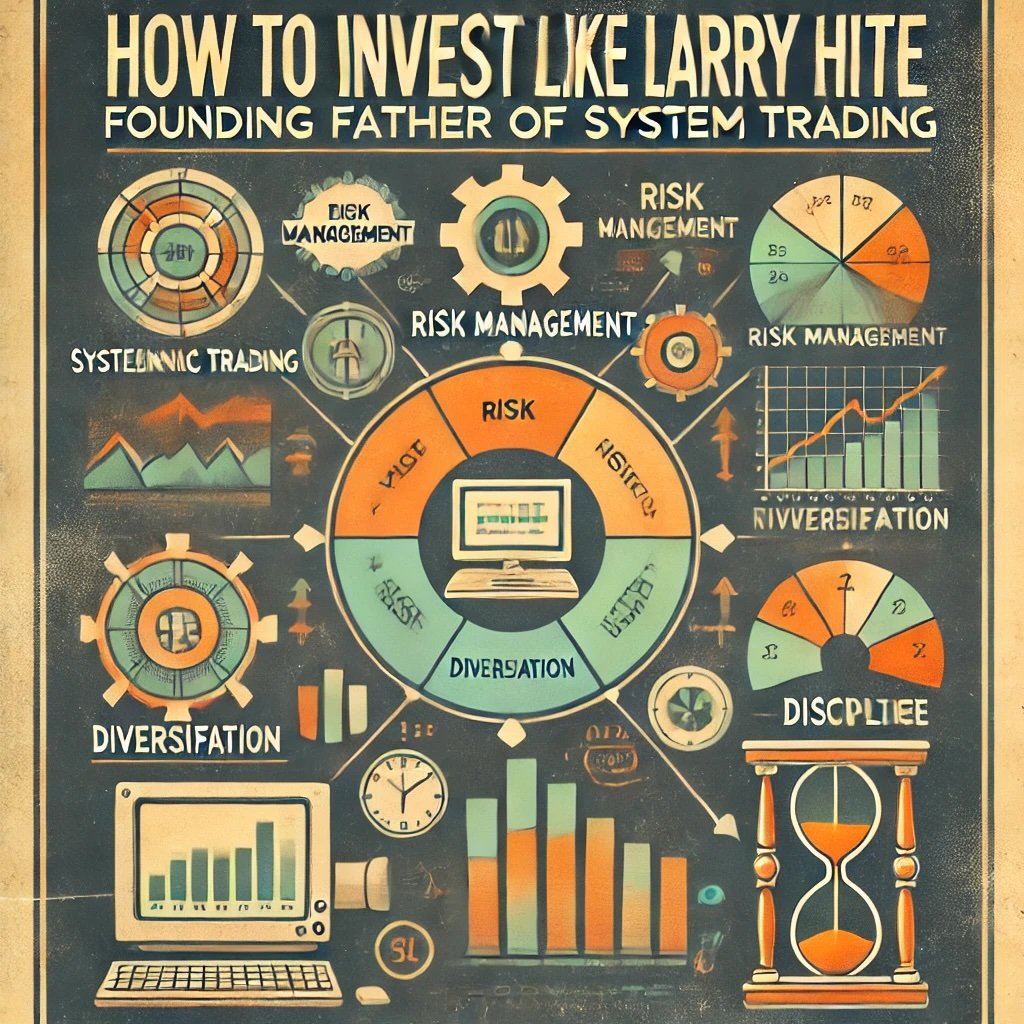The riveting saga of global investing is teeming with dynamic narratives, vibrant characters, and intricate plots. One of the most captivating chapters of this tale is undoubtedly the unfolding story of emerging markets.

Unveiling the Tapestry of Emerging Markets: The Hidden Gems of Global Investment
These markets, spanning across continents, from the pulsating cities of India and China to the bustling economies of Brazil and South Africa, represent a wide swath of cultures, socio-political scenarios, and economic dynamism. They are the hidden gems glittering amidst the vast expanses of global economies, teeming with untapped potential and alluring growth prospects. Yet, as enchanting as these economies are, they come bundled with their share of uncertainties and challenges, making the journey of exploring these territories a thrilling roller coaster ride for investors.

The Delicate Equilibrium: Teetering Between the Peaks of Opportunities and Valleys of Challenges
Investing in emerging markets is akin to performing an intricate ballet on the global financial stage. The dancer (investor) must exhibit a robust sense of balance, maintaining a delicate equilibrium between the towering peaks of lucrative opportunities and the daunting valleys of inherent risks. These markets, while promising astronomical returns, can equally expose portfolios to significant volatility stemming from economic instability, political upheaval, and regulatory ambiguities. This article aims to be your sturdy anchor, offering insights and guidance, enabling you to maintain your footing amidst the constantly shifting sands of these vibrant economies.

A Glimpse into the Investment Odyssey: The Exciting Voyage Ahead
Embarking on the voyage of exploring emerging markets requires a steadfast compass to navigate the vast expanse of information and nuances. This article aspires to be that compass, guiding you through the turbulent waters and unchartered territories of these burgeoning economies. We’ll meticulously dissect the anatomy of key emerging markets, including the much-talked-about BRICS (Brazil, Russia, India, China, and South Africa) and the promising MINT (Mexico, Indonesia, Nigeria, and Turkey) nations. We’ll delve into their unique attractions, potential pitfalls, and effective strategies for investment. The aim is to equip you, the astute investor, with the necessary knowledge and understanding to maximize the benefits while mitigating the risks in your quest for promising and profitable investment avenues. So, strap on your seatbelt and prepare for an exhilarating exploration as we navigate the fascinating labyrinth of emerging market investments together.

Understanding Emerging Markets
The Emergence of a New Dawn: Defining Emerging Markets
The investment landscape is akin to an artist’s canvas, constantly evolving, adding new hues and shades. The freshest colors on this canvas are those of the emerging markets. But what, you may wonder, constitutes an emerging market? Generally, an emerging market economy is characterized by its rapid growth and industrialization, but with lower per capita incomes, market efficiency, and stability than developed countries. These are nations transitioning from developing economies, marked by agrarian focus, to more sophisticated ones with burgeoning industry and service sectors. They exhibit characteristics like a dynamic and growing middle class, improving infrastructure, and significant market openness. Yet, these economies also grapple with challenges such as political instability, regulatory inconsistencies, and economic volatility, making them a vibrant mosaic of opportunities and risks.

The Mosaic of Growth: Major Emerging Markets
Our journey through the terrain of emerging markets starts with the famed BRICS – Brazil, Russia, India, China, and South Africa. These nations have carved a distinct niche for themselves, exhibiting promising growth narratives and a substantial influence on global economic dynamics. Alongside BRICS, we also find an equally fascinating grouping known as MINT – Mexico, Indonesia, Nigeria, and Turkey. They present an intriguing blend of geographic, economic, and demographic diversity, adding another layer of complexity and opportunity to the emerging market narrative. Along with these, we’ll also explore other burgeoning markets that are gradually carving out their space on the global investment map, including nations like Vietnam, the Philippines, and Colombia.
The Engine of Progress: Key Growth Drivers in Emerging Markets
The story of emerging markets is one of transformation and progress. This narrative is driven by several key factors. The rapid pace of industrialization, the rise of a vibrant middle class, technology adoption, and favorable demographic trends are the key propellers of growth in these markets. The proliferation of digital technologies and internet connectivity is revolutionizing business models and opening up untapped consumer markets. Simultaneously, policy reforms and increased global integration are improving the ease of doing business, attracting foreign investments, and fostering economic stability. Yet, while these growth engines promise attractive returns, they also expose these markets to unique risks and challenges, providing a compelling backdrop for our ongoing exploration of emerging market investments.
source: Rob Berger on YouTube
The Investment Potential of Emerging Markets
The Thrill of Growth: High-Growth Prospects and Demographic Advantages of Emerging Markets
Like a thrilling novel full of suspense and promise, the emerging markets offer a tantalizing narrative of economic growth and demographic vitality. These markets are the epitome of dynamism, characterized by rapid economic expansion and industrialization. Indeed, many of these countries consistently outpace their developed counterparts in terms of GDP growth, presenting lucrative opportunities for investors. Simultaneously, the demographic advantages of these regions cannot be overstated. With younger and increasingly affluent populations, these markets have the potential to unleash a surge of consumer demand, driving growth across industries from retail and e-commerce to healthcare and finance.

The Harmony of Variety: Diversification Benefits and Potential for High Returns
Emerging markets are akin to a vibrant, multi-colored tapestry, each thread contributing a unique hue to the larger design. Investing in these markets allows investors to weave this varied palette into their portfolios, offering significant diversification benefits. With their distinct economic cycles and market dynamics, these markets can help reduce portfolio volatility and enhance risk-adjusted returns. More so, the potential for high returns in these markets is enticing. While the risks are undeniably higher, the rewards can be substantial for those willing to navigate the complexities of these markets.
Triumphs of the Bold: Real-World Examples of Successful Investments in Emerging Markets
We needn’t look far to find compelling tales of successful investments in these vibrant economies. Consider the riveting story of an investment in MercadoLibre, the e-commerce giant that has come to dominate the Latin American market. Investors who recognized the company’s potential and braved the volatility inherent in the region have seen tremendous returns. Or take the example of Tencent, a remarkable testament to China’s meteoric rise in the global digital economy. These are but two instances of the numerous success stories that dot the landscape of emerging markets, offering both encouragement and lessons for prospective investors. Each of these stories underscores the potent combination of careful analysis, patient capital, and an appreciation for the unique rhythms of these exciting markets.
source: Ben Felix on YouTube
The Challenges and Risks of Investing in Emerging Markets
The Storms of Change: Market Volatility and Political Risks
Investing in emerging markets is akin to sailing on uncharted seas, where tranquility can swiftly give way to tempestuous storms. Market volatility is an intrinsic part of these markets, driven by a plethora of factors from economic policy changes to geopolitical tensions. Political risks further add to this volatility. Governments can change, policies can be reformed overnight, and political instability can jolt the market, all of which can result in significant fluctuations in investment values. Navigating these waters requires a deep understanding of the political landscape, a weather eye on the horizon, and a readiness to adjust course as needed.

Unseen Rocks and Shoals: Currency Risk, Regulatory Risk, and Lack of Market Transparency
Yet, the perils of investing in emerging markets aren’t confined to political and market volatility alone. Other challenges lurk beneath the surface, akin to unseen rocks and shoals ready to ensnare the unwary. Currency risk is a prominent concern, as fluctuations in exchange rates can significantly impact investment returns. The regulatory environment can also be fraught with uncertainties, as rules and regulations can change unpredictably and vary widely between countries. Furthermore, a lack of market transparency can pose substantial challenges, with limited access to reliable information and lower standards of corporate governance being commonplace.
Cautionary Tales: Real-World Examples of Investments That Faced Challenges in Emerging Markets
The investment landscape in emerging markets is dotted with cautionary tales that provide invaluable lessons for investors. Take the case of investors who bet heavily on the Brazilian oil giant Petrobras, only to witness their investments dwindle amidst a corruption scandal and falling oil prices. Or consider the investors lured by the prospect of India’s burgeoning infrastructure sector, who were later stung by regulatory hurdles and slow project execution. These examples underscore the inherent risks of investing in emerging markets and emphasize the need for thorough due diligence, a disciplined investment approach, and a robust risk management strategy.
source: Investing Made Simple – Nathan Sloan on YouTube
Strategies for Investing in Emerging Markets
The Power of Knowledge: Importance of Research and Due Diligence
When venturing into the enigmatic landscape of emerging markets, knowledge is indeed power. Conducting rigorous research and due diligence is akin to drawing a map of uncharted territories. This involves understanding the macroeconomic fundamentals, such as GDP growth, inflation rates, and fiscal policies of the respective countries. It also entails an examination of the micro-level dynamics like company fundamentals, industry outlook, and competitive positioning. The more detailed your map, the better prepared you are to navigate the market’s unpredictable terrain.

Spreading the Risk: Diversification within Emerging Market Investments
As the old adage goes, “Don’t put all your eggs in one basket.” This wisdom holds especially true in the context of emerging markets, given their volatile nature. By spreading investments across different countries, sectors, and asset classes, you can reduce the impact of a poor performing investment. Diversification doesn’t guarantee against loss, but it can help buffer against the impact of any single market’s performance and potentially improve risk-adjusted returns.
Tools for the Journey: Role of ETFs, Mutual Funds, and Direct Stocks in Emerging Market Investing
Just as an adventurer has different tools for different terrains, an investor too has an arsenal of investment instruments to venture into emerging markets. Exchange-Traded Funds (ETFs) and mutual funds allow investors to access a broad array of companies across various sectors and countries in a single investment, providing an instant diversification benefit. For the more adventurous, investing in direct stocks offers the possibility of higher returns, albeit at a higher risk. It’s like choosing between a well-traveled path and forging your own trail. Both can lead to the treasure, but the choice depends on your risk tolerance, investment expertise, and the thrill you seek from the investment journey.
source: fu academy on YouTube
Case Studies: Successful Investments in Emerging Markets
Tracing the Success Trails: Examination of Successful Investments in Various Emerging Markets
As we voyage into the world of emerging markets, we’ll navigate the landscapes painted by successful investors who have already ventured into these regions. Let’s step into the shoes of investors who found gold mines in the bustling streets of Mumbai, the manufacturing hubs of Shenzhen, or the mineral-rich soils of Johannesburg. We’ll explore stories of triumph in volatile terrains, like the rise of MercadoLibre, often called the “Amazon of South America,” or the success saga of Tencent, a giant in China’s tech industry. Each narrative is a unique blend of strategic acumen, market understanding, and sometimes, just riding the wave of economic growth.

The Winning Game Plan: Strategies Employed and Lessons Learned from These Cases
Successful investing in emerging markets is often more than just a game of numbers; it’s a game of strategies. Some investors have played the long game, banking on sustained economic growth and the rise of the middle class in countries like India and China. Others have scored by identifying unique market niches, like investing in renewable energy in Brazil or fintech in Kenya. The tactics are as diverse as the markets themselves, but common threads weave these success stories together: thorough research, diversification, patience, and an appetite for risk.
Translating Stories into Strategies: How These Lessons Can Be Applied to Your Portfolio
While every investment story is unique, they often leave behind nuggets of wisdom that can be incorporated into our investing playbook. Perhaps it’s the tenacity to hold onto an investment despite short-term market fluctuations, or the insight to identify a market trend before it becomes mainstream. These case studies serve as a compass, guiding us towards possible opportunities and alerting us about potential pitfalls. As we learn from these success stories, we can craft our investment strategies, customizing them to align with our financial goals and risk tolerance.
source: The Aspen Institute on YouTube
Conclusion: Opportunities and Challenges of Investing in Emerging Markets

As we close this exploration of the labyrinthine world of emerging markets, it’s time to take a step back and survey the terrain we’ve covered. The sprawling landscapes of these markets, from the bustling cityscapes of Shanghai to the manufacturing hubs of São Paulo, all hold a common promise – opportunities for substantial growth and diversification. Yet, these lands are also fraught with challenges: the unpredictable weather of political volatility, the rough terrains of regulatory risk, and the uncertain paths marked by currency fluctuations. It’s an adventure not for the faint-hearted but for the well-prepared.

The Final Brush Strokes: Thoughts on Integrating Emerging Markets into a Well-Balanced Portfolio
In the art of investing, every portfolio is a unique canvas, reflecting the investor’s financial goals, risk tolerance, and investment philosophy. And emerging markets? They’re vibrant colors, ready to add depth and contrast to your masterpiece. But just like any strong pigment, they must be used judiciously. For an investor ready to navigate their complexities, they can serve as powerful strokes that enhance the overall investment picture, offering potential for higher returns and an effective diversification tool.
The Journey Continues: Further Study in the Field of Emerging Market Investments
Our exploration into the world of emerging markets is just a starting point – a compass guiding you towards new horizons. As with any investing expedition, the journey doesn’t end here. The map of emerging markets is ever-evolving, shaped by socio-economic changes, technological advancements, and geopolitical shifts. The successful investor is an avid learner, adapting and growing with these changes. So, pack your bags with resilience, arm yourself with knowledge, and step into the exciting world of emerging market investments. After all, every great explorer thrives on curiosity and courage. Safe travels, intrepid investor!
Important Information
Comprehensive Investment Disclaimer:
All content provided on this website (including but not limited to portfolio ideas, fund analyses, investment strategies, commentary on market conditions, and discussions regarding leverage) is strictly for educational, informational, and illustrative purposes only. The information does not constitute financial, investment, tax, accounting, or legal advice. Opinions, strategies, and ideas presented herein represent personal perspectives, are based on independent research and publicly available information, and do not necessarily reflect the views or official positions of any third-party organizations, institutions, or affiliates.
Investing in financial markets inherently carries substantial risks, including but not limited to market volatility, economic uncertainties, geopolitical developments, and liquidity risks. You must be fully aware that there is always the potential for partial or total loss of your principal investment. Additionally, the use of leverage or leveraged financial products significantly increases risk exposure by amplifying both potential gains and potential losses, and thus is not appropriate or advisable for all investors. Using leverage may result in losing more than your initial invested capital, incurring margin calls, experiencing substantial interest costs, or suffering severe financial distress.
Past performance indicators, including historical data, backtesting results, and hypothetical scenarios, should never be viewed as guarantees or reliable predictions of future performance. Any examples provided are purely hypothetical and intended only for illustration purposes. Performance benchmarks, such as market indexes mentioned on this site, are theoretical and are not directly investable. While diligent efforts are made to provide accurate and current information, “Picture Perfect Portfolios” does not warrant, represent, or guarantee the accuracy, completeness, or timeliness of any information provided. Errors, inaccuracies, or outdated information may exist.
Users of this website are strongly encouraged to independently verify all information, conduct comprehensive research and due diligence, and engage with qualified financial, investment, tax, or legal professionals before making any investment or financial decisions. The responsibility for making informed investment decisions rests entirely with the individual. “Picture Perfect Portfolios” explicitly disclaims all liability for any direct, indirect, incidental, special, consequential, or other losses or damages incurred, financial or otherwise, arising out of reliance upon, or use of, any content or information presented on this website.
By accessing, reading, and utilizing the content on this website, you expressly acknowledge, understand, accept, and agree to abide by these terms and conditions. Please consult the full and detailed disclaimer available elsewhere on this website for further clarification and additional important disclosures. Read the complete disclaimer here.





